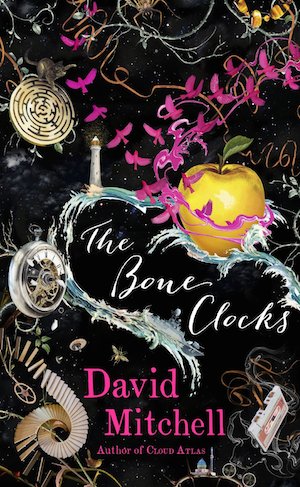As you’re aware, I’m a big David Mitchell fan and I know many of you out there like him too. I’ve just finished his latest book, The Bone Clocks, and I’m left with mixed feelings. The book has moments of pure Mitchellesque brilliance: fast-paced dialogue, inventive characters and addictive plots. The first four parts (there are six) were compulsive reading; the last two might delight sci-fi lovers, but sadly didn’t quite work for me.
Like Cloud Atlas, The Bone Clocks is made up of six different stories, all interconnected. The red thread is Holly Sykes, who we first meet as a 15-year-old runaway. The next parts are all about people in Holly’s life, some tangential, some central. It’s a compelling way to tell a story, which, at its heart is the story of Holly.
Mitchell’s books are crowded with imaginative and believable characters. Holly’s obsession with her first bad-boy boyfriend, the fights with her mother, the awkward dialogue, it’s as if we are living and breathing inside the body of a 15-year-old girl.
Then there is the delightfully revolting Hugo Lamb, a Bullingdon Club style child of the Thatcher era, a cynical bastard, a jerk to his friend and an asshole to his girlfriends, who lives by the adage: ‘who is spared love is spared grief’. Hugo seduces Holly in a Swiss ski resort in the early 1990s.
Jumping forward to 2004, Holly is married to war reporter Ed Brubeck, who’s torn between the demands and the adrenaline kick of his job and the needs of his family.
Ten years later, at the Hay festival, Crispin Hershey, ‘the Wild Child of British Letters’ (and a barely disguised Martin Amis) runs into Holly, a now famous writer about the paranormal. Crispin’s literary career is in decline, partly due to a scathing review by a famous critic, upon whom Hershey exacts a brutal revenge.
Hovering in the background of all these stories are paranormal episodes, mysterious happenings, people appearing out of thin air or disappearing never to be seen again. Mitchell oscillates between every day reality and the creepily supernatural, but does it with such confidence and elegance that the most unbelievable happenings almost appear believable. At times the story takes on horror film like qualities, such as when Holly discovers the bodies of two of her friends.
Cautiously I call Heidi’s name but she doesn’t stir. Bees graze the herby hedge, sheep baaa, a tractor drones away. […] Then I notice three, four, more busy black dots zigzagging up Heidi’s arm. I take a proper look ‘cause they can’t be ants…They are. ‘Heidi! You’ve got ants crawling up you!’ But she doesn’t react. I sort of brush the ants off her, but I smear a couple by mistake. What’s wrong with them? ‘Heidi! I shake her arm harder, and she slides over onto the side arm of the lounger, like a comedy drunk, but this isn’t funny. Her head slumps over and her sunglasses slide off and then I see her eyes – they’re all iris and no black bit in the middle.
In the fifth part, which takes place in 2025, we learn what these events have been all about: the battle between the Anchorites, who achieve eternal life by killing, and the Horologists, who live forever through resurrection. The bad guys and the good guys, basically. Sci-fi fans might find this part fascinating, but sadly, this is where Mitchell lost me. It all goes a bit too Star Warsy for my taste.
The final part is in 2043. The world has gone all apocalyptic; natural disasters, global hunger and epidemics rage. Society has collapsed.
Mitchell’s books burst with energy, originality and playfulness; his writing is dense and fast-paced. But in this book it’s almost as if gets caught up in his own creativity and spins out of control. The Bone Clocks is not his best, but don’t let this turn you off reading his previous or, indeed, next book when that comes out.
The Bone Clocks by David Mitchell is published by Sceptre, 595 pages.





